In the case of the SUV trend and its escalation "downwards", something similar has happened. The Hiroshima firm was already aware of this type of car, thanks to its large presence in the United States, a market that served to justify the creation of the CX-9 and CX-7, the latter being a more than adequate product, which ended up having its space in Europe.
After the small "SkyActiv" revolution, the Japanese brand has entered two more SUV segments. First it did it with the CX-5, a car that straddles the C and D segments (more "de" than "ce"), and now it's attacking another increasingly important segment, that of the B-SUV.
Dani was delighted at the presentation of the CX-3 in Barcelona, but we had to spend a week with the car to be able to validate the impressions of a few kilometers through an intensive and daily use of seven days. To do this we have the most pompous and expensive version of the range: The two-liter petrol 150 hp, associated with the automatic gearbox six-gear automatic gearbox and all-wheel drive. Come on, the variant that will find fewer customers in our market for sure.
Design
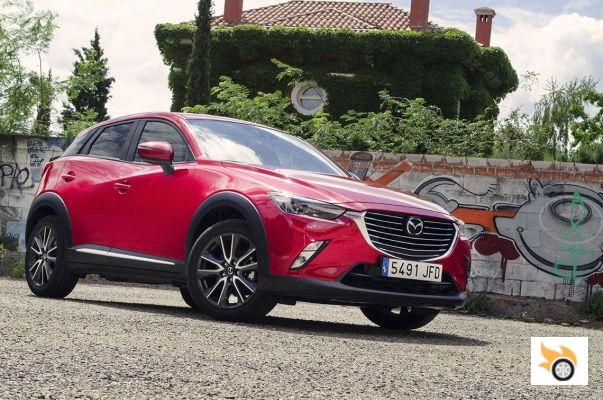
The SUVs enter through the eye. The first reason for its commercial success is in aesthetics, and not in the need for "a tall car" of the end customer. That's why it's especially important for the car to be aesthetically pleasing in order for it to work commercially.
The case of the CX-3 is a success. The unanimous opinion about the car is that it is attractive. And it is despite being closely related to the Mazda2, with which it even looks similar. But the differences are more important than the similarities. Thus, the wheel arches in black plastic well marked together with the front "pissed off" give the car "visual power" beyond where it reaches the utility of the firm.
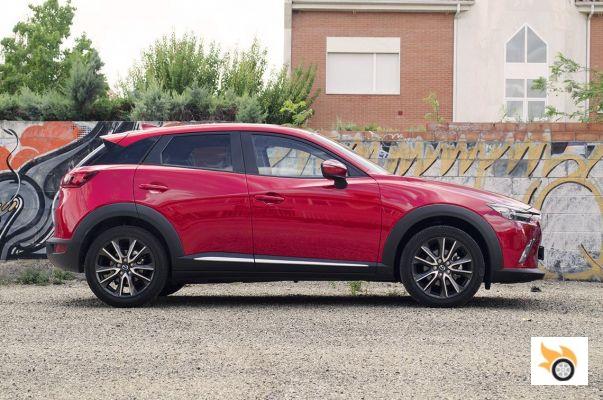
The side view plays with the two typical and ubiquitous crisscross styling lines already ubiquitous throughout the Mazda range, with one "down" from the front wing and another that crosses to generate the rear, with a resource that we saw come back into fashion this century by the hand of the current SEAT Ibiza.
The rear view, with the rear lights also playing that "pissed off" and the C-pillar mimicked based on a third side window and a pillar painted in black and attached to the spoiler complete an attractive aesthetic, dynamic, muscular and that you enter through the eye.
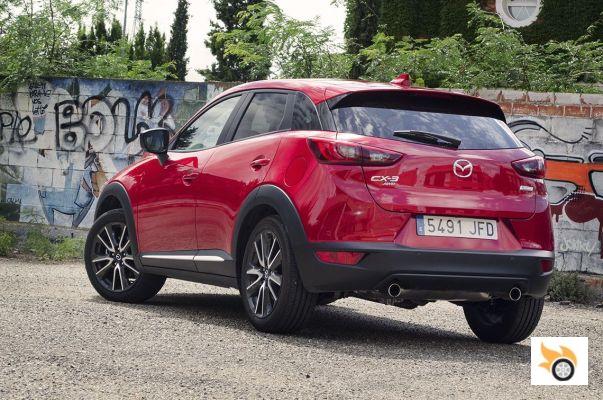
Interestingly, the car also achieves an effect of "national recognition", and it is one of those cars whose origin is clear at first glance: It's Japanese, and it feels Japanese, something that also happens in other notable and more expensive examples (Lexus IS, Lexus LFA, Nissan GT-R...).
Cabin
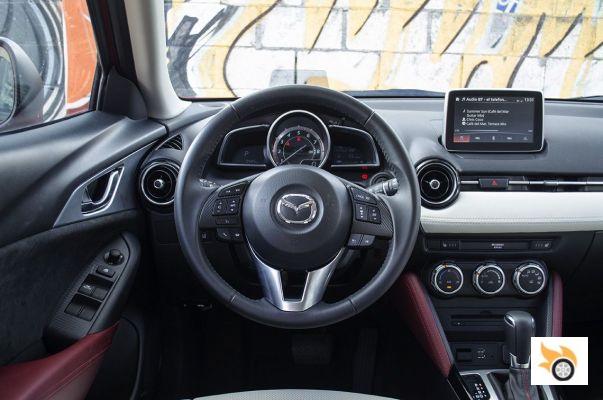
If on the outside there are few elements that relate the Mazda2 with the CX-3, inside things change radically. Here practically everything or almost everything is common between the two range brothers. And that's not a bad thing, as the Mazda2 was a top performer in the B-segment, and the CX-3 does the same in the B-SUV.
The test unit, which had the higher trim level, also featured the instrument cluster with the rev counter as the main clock, with the speedometer nestled inside, which we like so much. The side screens are easy prey to sun glare, which can make it difficult to see them completely, so having the information centered is good.
Materials, fittings... everything looks good. The infotainment system is the same as the rest of the Mazda range, so I won't describe it again and will just tell you that we like the way it works.
What we don't like so much in the front seats, which enjoy good driving position and a comfortable seat, is the HUD system. Added as a plus for this segment, the retractable plastic screen gives the CX-3 an air of fighter plane that looks good, but the way of displaying information through a screen whose resolution is not higher than that of your first Game Boy, and a bed of colors reduced to a green "Amstrad" do not end up convincing with respect to the rest of the car. One remembers what the HUD screen of an equivalent MINI looks like and the comparisons can be odious in the British car's favour.
While the front seats allow you to find a great driving position, being generous in space as well, the rears are not so much when one takes the ruler and compares with its rivals. Here there is less legroom and the ground clearance is tight.
In terms of boot space, with 350 litres it doesn't have much of a problem (it's in line with what its rivals offer), with the only downside being the fact that there's a threshold in the tailgate that means the load floor isn't flush with the access.
All in all, if you're going to put children in the rear seats, you won't miss the space. If you're going to fit adults with the idea of long journeys, you'd be better off looking at another alternative.
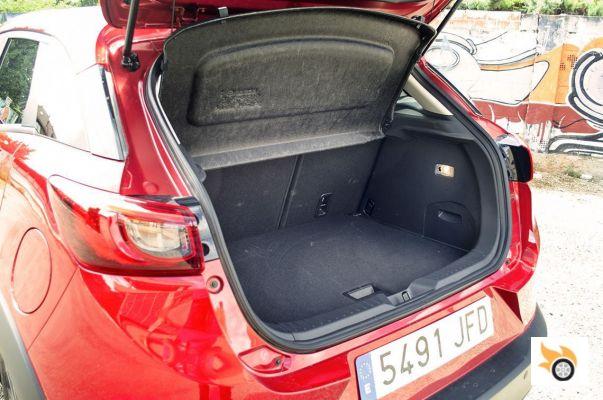
Technology
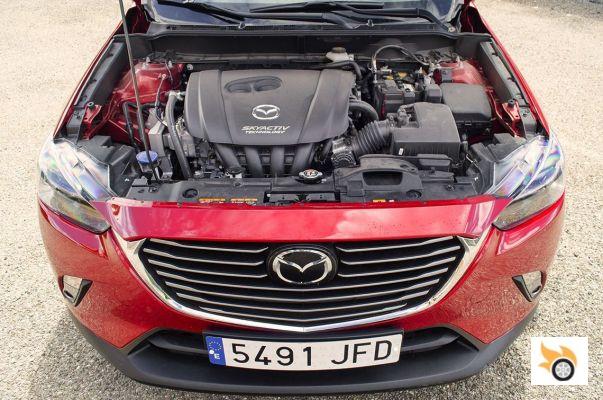
There are few surprises here. It shares a platform with the Mazda2, itself derived from that used in the rest of the firm's larger models, but with its own rear suspension with trailing arms linked by a torsion bar. It is curious to see a rear suspension system of this type in a car with all-wheel drive.
The engine is a two-litre SkyActiv petrol in our case, with 150 naturally aspirated horsepower with 14:1 compression ratio, although it can drink 95 octane petrol with no problem. The six-speed automatic gearbox with torque converter sends the engine's effort normally to the front wheels, but if it notices any loss of driveability it acts on an electronic centre differential to send some of the torque to the rear axle.
The "center" differential is located on the rear axle and is a multi-disc system. When the car works exclusively as front-wheel drive, the drive shaft that reaches the rear of the car continues to rotate, creating friction, but in exchange for this extra energy expenditure what is achieved is that in case of needing torque on the rear axle, the drive of the same is faster.
The complete car weighs 1,340 kilos, which given the circumstances and the type of traction can be considered even a tight weight, although they are 340 kilos more practically than the Mazda2. These are kilos that, if you don't use the car off-road, you'll only have as an extra for aesthetic reasons.
How it drives
Mazda has a different set-up for each of the CX-3's engines. This is worth remembering when opting for this car. I was warned by Dani before testing it, as the diesel opts for a relatively soft and comfortable suspension setting, while this 150 hp petrol and all-wheel drive car has a more "sporty" tuning.
In the city it is a car that handles as well or better than the Mazda2, as you sit a hair higher, and as it is compact in its dimensions, it can be placed anywhere. The 150bhp petrol engine is a delight, because it's smooth, flat in its response, has a pleasant engine tone and the long accelerator pedal allows you to manage it carefully.
The Start&Stop system with dual-layer supercapacitor works wonders, and allows you to make stoplight exits immune to engine restart. The only downside I see to the car in this area comes from the automatic gearbox. Is it bad? No. But the manual gearbox in these cars is so delicious, so good, that opting for an automatic gearbox, whose laws of operation and slipperiness are not up to the standard of a state-of-the-art dual clutch, means that the car is not as good as it could be.
The suspension, while firm, allows you to get over manhole covers and bumps without having to slow down too much or bounce excessively. Only the rear axle seems to want to bounce a little more than you'd like when you've gone over a bump. The car is rated at 7.8 litres per 100 km, but we didn't get less than 9.5 in urban use. It is curious to see how the extra weight influences so much, as a Mazda3 with the same engine in the city, but with manual gearbox, spends clearly less.
If we go out on the road and we consider long trips, it is a comfortable car, with a bigger car tread and an engine capable of withstanding high cruises without a fuss, with acceleration reserve for overtaking, and with an average consumption that here can go down to six and a half or seven liters.
The drawbacks in this type of driving come from the aerodynamic noises in the rear-view mirror area at 120 km/h, the rolling noise of the Toyo Proxes, clearly superior to that of more expensive tyres, and an adaptive cruise control that is not as refined as that of other brands.
While it maintains speed and distance to the car in front when you've been behind it for a while, it's clunky when you get behind a slower car. Let's say you're doing 120 on a motorway, overtaking a line of lorries, and you come across a van overtaking at 100 mph. The normal thing to do in these systems is to brake gently from the moment you see the car in the distance until you reach the preset safe distance. The CX-3 has braver ideas, and will take you faster until the distance is small and then brake harder than you'd like.
No, you don't crash, and no, it's not dangerous, but it's more uncomfortable and uneasy than with other systems from other manufacturers.
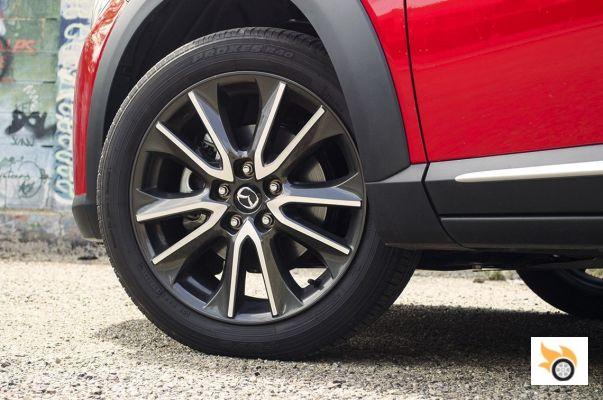
And what about spirited cornering? Mazda's already legendary cornering behaviour is once again present. The car has a stiffer set-up, restricting body roll and sway more than the diesel CX-3, the Mazda2 or the Mazda6 we've been testing these days.
The ride is crisp, the steering is weighted and direct, and the car swallows any bumps in the middle of the road without getting bent out of shape. The rear is not "agile" so it won't give you any scares, but it won't play at rounding corners with you either. On the plus side, the car "flows" rather than being clumsy or choking through corners like it's got an anvil on the front end. It goes as well or better than virtually all of its segment rivals, playing in the same league as the 500X we tested months ago.
The drawbacks in dynamic driving come in any case from several fronts. The torque converter automatic transmission, despite having manual paddle shifters behind the steering wheel, isn't a prodigy of speed, and if left to its own devices it makes a mess of the ratios in full support. The feel of the brake pedal leaves something to be desired, due to being an automatic car, with some initial sponginess, the feeling of not having absolute control of the modularity of the braking. In addition, it is missing some more power in "the anchors" when one is demanding what the car is capable of doing.
Finally, the engine, which a priori is full and can be stretched to the top with joy, at the moment of truth is somewhat decaffeinated. I don't know if it's because of the fact that it moves 1,300-odd kilos, because of the all-wheel drive system or because of the gearbox. Whatever it is, it seems to lack "the big finish". The torque curve is flat, and I've already told you above that it's good for progressive driving, but on the attack it feels like the bottom end of the rev counter lacks punch and just adds noise to the equation. The fact that the o to 100 with the manual gearbox drops by almost 10 seconds (9.6) and the 80-120 we couldn't get it down from almost seven seconds shows that, despite managing 150 horsepower, it's not a "really fast" car, but simply "resultón".
The fact that the Toyo tyres once again prove to be poor cornering tyres is no longer surprising, so, as in previous cases, my strong recommendation is that if you buy this car, when you can change them or it's your turn to change them, you should opt for better quality tyres.
Conclusions
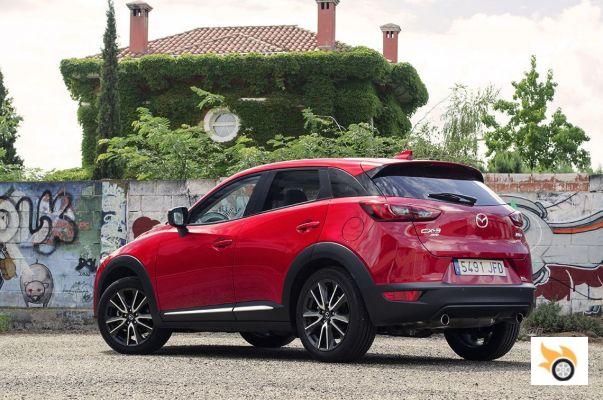
Summarizing everything in a few words, it is easy to draw differences with its rivals. The CX-3 aesthetically enters through the eye. The cabin is better finished, designed and resolved than many of its rivals, although it lacks space in the rear seats.
In quiet driving on highways and motorways is a good car for comfort, although it has some aerodynamic whistling and cruise control radar is a bit hardcore, and in attack driving behaves better than most B-SUV.
The 500X seems to me to be its most solid rival for dynamic handling if you're looking for a B-SUV with good cornering manners to enjoy driving.
Specification to buy? Well, the first question to ask is whether you really need all-wheel drive, as it makes the car more expensive. But the problem is that the two-litre 150 hp petrol is only available as a 4×4. I would do without the automatic gearbox, as this car is better in manual. You have to bear in mind that the average fuel consumption is going to be between 7.5 and 8 litres per 100km. And last but not least, you have to get rid of the Toyo on the first wheel change.
Would I buy it? If I was looking for a B-SUV right now for 25.000€ (take that), I'd be between this and the 500X.

























